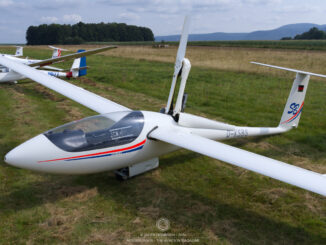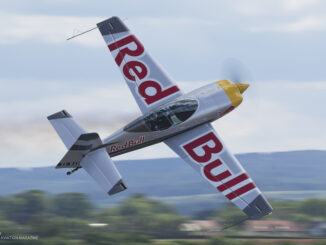 Aero Ae 270 Ibis (c/n 008, OK-ALE), performing a flying display during the Open Doors Day at the 21st Tactical Air Force Base, Čáslav, May 2013.
Aero Ae 270 Ibis (c/n 008, OK-ALE), performing a flying display during the Open Doors Day at the 21st Tactical Air Force Base, Čáslav, May 2013.
Somewhere in the 1980s, the idea of creating a modern utility aeroplane was born in then-Czechoslovakia. The aircraft was planned as a single-engine turboprop utility low-wing monoplane, similar in configuration and role to the Cessna 208 Caravan and Pilatus PC-12.
Initially, the aircraft was developed at the Moravan aviation plant in Otrokovice, where it was designated L-270. However, later on the project was assigned to Aero Vodochody, the company well known for its L-39 Albatros jet trainer.
At Aero, the project was redesignated Aero Ae 270. However, due to the challenging economic situation that followed the collapse of the Eastern Bloc, the programme suffered from insufficient financing and development progressed very slowly. In the early 1990s, the company focused its efforts on modernising the L-39 and developing a new military jet for the Czech Air Force (which eventually resulted in the L-159 ALCA). Consequently, the utility aircraft programme was effectively abandoned.
The Ae 270 programme was revived in 1997, as a by-product of the L-159 development. The Aerospace Industrial Development Corporation (AIDC), a Taiwanese aerospace company that supplied F124 jet engines for the ALCA project, became interested in the future utility aircraft. Shortly after, IBIS Aerospace Limited – a joint venture between Aero and AIDC – was founded and took over the further development of the aircraft.
Over the next few years, the Czech-Taiwanese cooperation appeared to be really productive. A few prototypes of the Ae 270 were built for static, fatigue, and flight testing. In 2000, the new utility aircraft successfully performed its maiden flight.
One of Aero’s official advertising materials from that period indicated that the Ae 270 would be manufactured in two main variants. The first version was to feature a pressurised cabin, retractable landing gear, and a Pratt & Whitney Canada PT6A-42A engine. The second version was to be powered by a Walter M601F and to have fixed landing gear and an unpressurised cabin. In addition, four different passenger and cargo configurations were mentioned.
One prototype of the Ae 270 was sent to the USA, where it participated in a few aviation exhibitions, marketed as the Ae 270 Spirit Propjet. The aircraft was also successfully certified by both EASA (2005) and FAA (2006). A total of eight examples of the aeroplane was built until the official end of the Aero-AIDC cooperation in 2006.
The aircraft that had already been produced were divided between the two former partners. At least two Ae 270s were then operated by Aero Vodochody as business aircraft until the 2010s.
Although rumours about the future of the Ibis programme regularly appeared in the Czech media, they usually lacked enough credibility. In 2016, Aero officially announced that the Ae 270 project had been sold to COPS Investment, a Nigerian-based company.
The acquisition of the Ibis programme included the transfer of all intellectual property rights, along with the EASA and FAA type certificates and the hardware. The Nigerian company intended to manufacture and sell the aircraft through its subsidiary, Aircraft Integrated Solutions (AIS), under the new designation AIS Spirit.
In 2019, when we published our first article mentioning the Ae 270, the latest update on the AIS corporate website dated back to 2017. In the ´news´ section only two items could be found at that time, both dated 2016 and illustrated with Aero-manufactured prototypes.
As of today, the AIS website has been completely redesigned and updated with a copyright notice for 2025. It also states the company has established new sales offices, one in Ireland and another in the United Arab Emirates. However, there is still no information about any newly manufactured aircraft.
The site continues to feature photographs of Aero-built prototypes and several renders of the AIS Spirit. Furthermore, the aircraft characteristics are still listed as ´planned specifications´ only. Nevertheless, the EASA type certificate for the Ae 270 was updated in 2021.



